Leopard Geckos are one of the more popular and loved reptiles in the industry. Being cute as a button, tame, easy-going, and with a relatively easy care level, it is easy to see why. As with other reptiles, you may have heard the term "morph" when it pertains to leopard geckos. A "morph" is a variation in size, shape, color, and pattern that makes each leopard gecko unique. Through selective breeding, there have been several defined morphs that have been created.
When I first got into reptiles, the majority of my experience was with bearded dragons, and I used to think there were a lot of bearded dragon morphs... I had no idea of the number of leopard gecko morphs! There are so many different types of leopard gecko, especially now that we have had them in captivity for a while; they have been bred to come in all sorts of different colors and patterns. There are always new morphs emerging and being created through breeding of different types of gecko, so it is challenging to keep up with all of them.
First, some terms will need to be known to be able to get a general understanding of the terminology that is sometimes used when describing a morph. Reptiles' genetics can get pretty complicated, and these terms are given a necessary explanation to make things more simple.
- Genetic Traits: These are physical characteristics that are determined by genetics.
- Recessive Traits: Traits that come from recessive genes. For a recessive trait to be physically expressed in the reptile, the same gene needs to come from both parents.
- Dominant traits: Unlike recessive traits, dominant traits physically represent even if they only come from one parent. If one parent carries a recessive trait and the other parent a dominant one, then the dominant feature will usually physically represent.
- Co-Dominant Traits: If two dominant traits are present, they can both physically represent, making them co-dominant.
- Phenotype: A word used to describe a physical characteristic.
- Genotype: Genotype refers to the genetic makeup of an individual.
- Line Bred: When geckos with specific characteristics are bred together to produce the same or improved characteristics. Also known as polygenic traits.
- Out-Crossing: The breeding of reptiles that display different characteristics; this is done to spread genes apart to reduce the risk of genetic defects. It is also done to try and produce offspring with new traits or to produce a particular outcome with regards to mixing traits.
- Homozygous: Leopard geckos that carry two of the same trait, one trait from each parent.
- Heterozygous: Heterozygous varieties carry a copy of one regular trait and one copy of a recessive or designer trait, one from each parent.
Below are some of the various morphs that you may encounter when it comes to Leopard Geckos. (There are many different variations and offshoots, so this list does not contain every single morph that exists)
Normal Morphs
Normal morphs are the standard gecko you will most commonly find, they are usually the ones you will fond at chain pet stores and are the most inexpensive of them all. Nothing wrong with owning one as a pet though, they are just as friendly and entertaining as any leopard gecko and suffer the least health issues due to certain morphs being bred incorrectly to gain specific characteristics.
Normal (Wild type)

(photo credit BizRate)
Your normal morph is the basic yellow gecko with black spots that all the other variations have stemmed from. These are the ones you will find in the wild and the least expensive and most readily available.
High Yellow

(photo credit vmsherp)
The high yellow is the most closely related to the normal morph type, and they resemble the normal but with a brighter yellow color, and with fewer spots. Still inexpensive and easy to find.
Albino Morphs
Whereas in most species, the albino trait has caused a complete lack of melanin to be produced, with leopard geckos, it has caused less of it to be produced. So rather than a complete lack of dark pigmentation, you will still see some.
Mack Snow

(photo credit monkfieldnutrition)
Pale with black bands, these leopard geckos are usually white at birth but develop the darker bands over time.
Super Snow
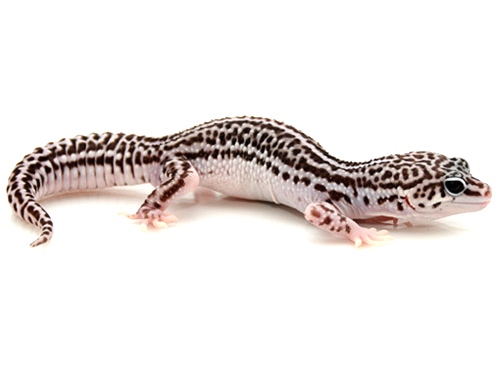
(photo credit backwater)
The result of breeding two mack snow geckos, these reptiles have solid eyes with heavy speckling all over.
Tremper/Texas Albino
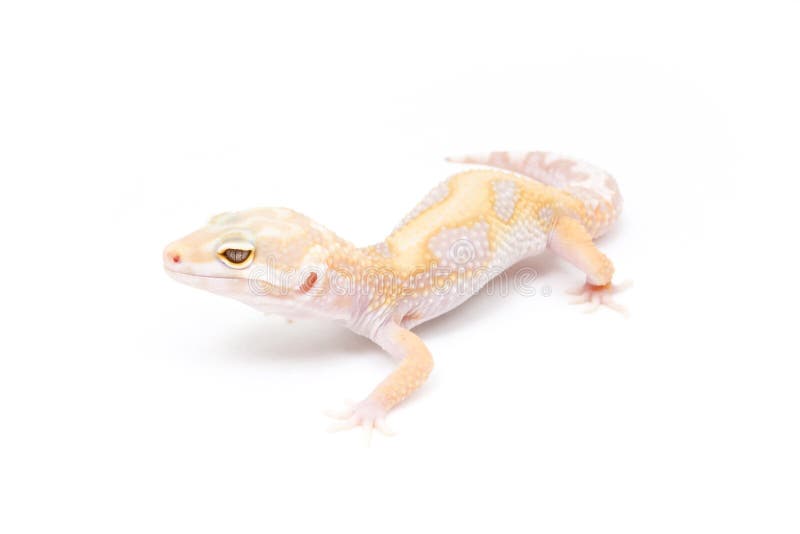
(photo credit Dreamstime)
Tremper Albinos were amongst the first albino morphs to be discovered. They have silver eyes with red veins and come in a variety of different colors such as brown, orange, yellow, and pink. They lack the dark spots and stripes of other morphs.
Bell Albino

(photo credit geckosetc)
Also known as the Florida Albino, usually lavender-ish with brown spots. A distinguishing characteristic is their pink eyes.
Rainwater Albino

(photo credit reptileforums.co.uk)
Rainwater Albinos are generally slightly smaller than other albinos and also lighter in colors. Hatchling rainwater usually have yellow bodies and pink bands. All Rainwater have typically darker eyes than other albinos and are sometimes known as Las Vegas Geckos.
Striped Leopard Gecko Morph
The striped morph displays a dark stripe that runs down the length of their bodies.
Bold Stripe

(photo credit Pinterest)
Bold Stripes show patterns and unique striping that run down the sides of their bodies rather than the middle of their backs. The physical appearance of this morph makes it highly desirable, and these can be very expensive.
Red Stripe

(photo credit geckotime)
Red Stripe Leopard Geckos have two reddish stripes that run down each side of their back. The stripes are not usually evident until around six months of age, and they are typically born with some brown coloration where the stripes will eventually appear.
Raining Red Stripe
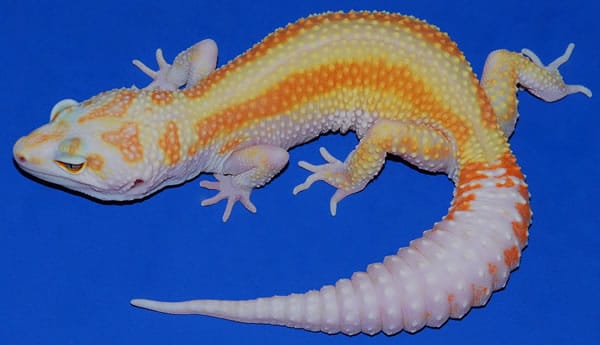
(photo credit ReptileAdvisor)
These are the result of crossing rainwater albinos with red/bold stripe morphs. They look like rainwater albinos, except they have red stripes. These are very highly sought after and get very expensive.
Giant Leopard Geckos
Just as the name suggests, this morph of the leopard gecko is bigger than usual. Some geckos are naturally just a bit bigger and are mistakenly labeled as giants when they are not true giants.
Super Giant
(photo credit reptilesmagazine)
This particular super giant is the homozygous version of the giant and is even bigger than the regular giant morph.
Godzilla Super Giant

(photo credit HerpZilla)
These are the biggest out of all the giant varieties, quite rare they are super expensive, easily being sold for over $1,000!
Hypo/Hyper Melanistic Morphs
Hypomelanatic (Hypo) has less melanin, which means they have much less spots on their bodies; they never have more than ten spots in total. They still have spots on their heads and their tail, however. Hypermelanistic means that they have more melanin than usual, giving them a darker pigmentation overall.
Super Hypo

(photo credit Pinterest)
Super hypos have no spots on their actual bodies, and they are generally yellow with spots on their heads and tails.
Baldy
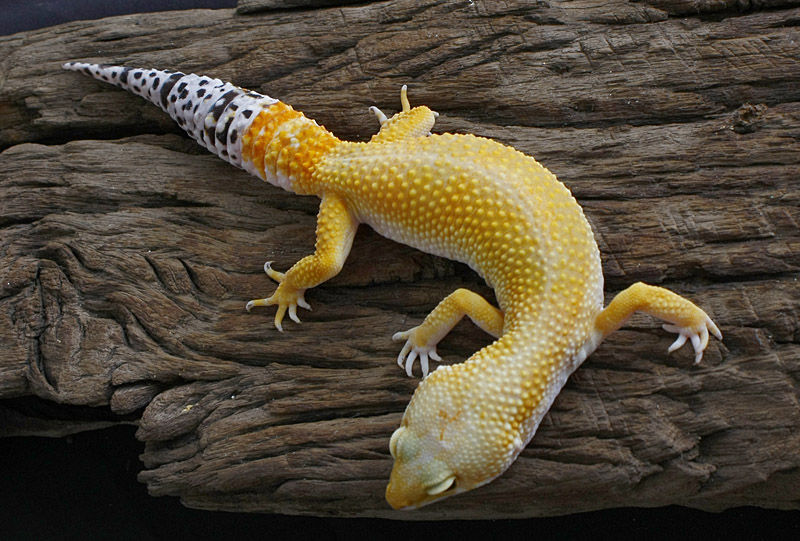
(photo credit Deviantart)
Baldies are a version of the super hypo, but they have no spots on their head. Known for their reddish tone, the redder they are, the more expensive they can get.
Hybino
(photo credit (snakesatsunset)
Hybinos/hyper-albinos are made by combining the super hypo morph with any other albino. Usually a solid yellow/orange-yellow with albino eyes. Also known as sunglow.
Hypo Ghost

(photo credit geckotime)
Also known as Ghost morphs, they are very light in color, which fades to an even lighter color as they age. Since they resemble mack snows as babies, they are often mislabeled and only identified as they mature.
Melanistic Leopard Geckos
True melanistic geckos would be all black; however, although it has been reported that they have been produced, there are know documented true melanistic. However, breeders are actively trying to produce them. The closest morphs are black velvets and black pearls. When they have been indeed produced, they are going to be extremely expensive.
Blizzard Leopard Gecko Morphs

(photo credit vmsherp)
Blizzard geckos are entirely devoid of any pattern; rather, they are a solid color across their entire body. They are usually white or yellow. Darker versions are sometimes known as midnight blizzards.
Banana Blizzard
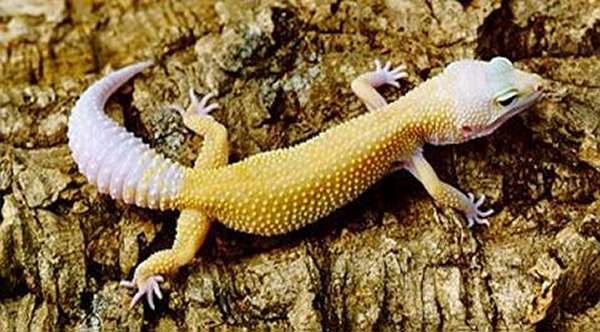
Sometimes yellow blizzard morphs are sold as banana blizzard, but true banana blizzard is yellow-colored patternless.
Blazing Banana Blizzard
(photo credit amazingwallpapers)
These are still under development by breeders, combining blizzard, patternless and albino traits. Their eyes will resemble the specific type of albino they have been bred from while their body will display characteristics consistent with the patternless they have also been bred from.
Patternless

(photo credit reptilecalculator)
Also known as Murphy Patternless, these leopard geckos have no identifiable spots once they have matured into adults. Very similar in appearance to the blizzard morphs. Usually, they are purple-ish or gray, although some are green or yellow.
Other
Certain other morphs have been produced that do not fit into the above categories.
Snake Eye
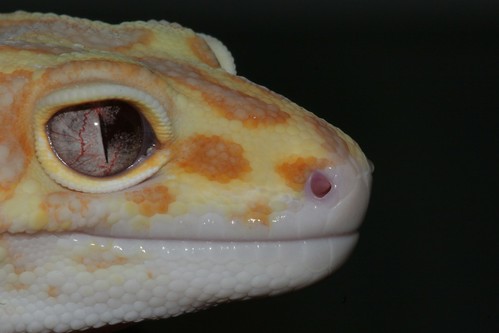
(photo credit Flickr)
Snake eyes are sometimes seen in the Blizzard, and Tremper Eclipse morphs. These have eyes that are not solid in color, giving the impression of a snake eye.
Aberrant Morphs
(photo credit reptilecalculator)
Their disrupted, broken patterns characterize aberrants. To be a true aberrant, the inconsistent pattern must be displayed only on the tail or on the body but not on both.
Jungle
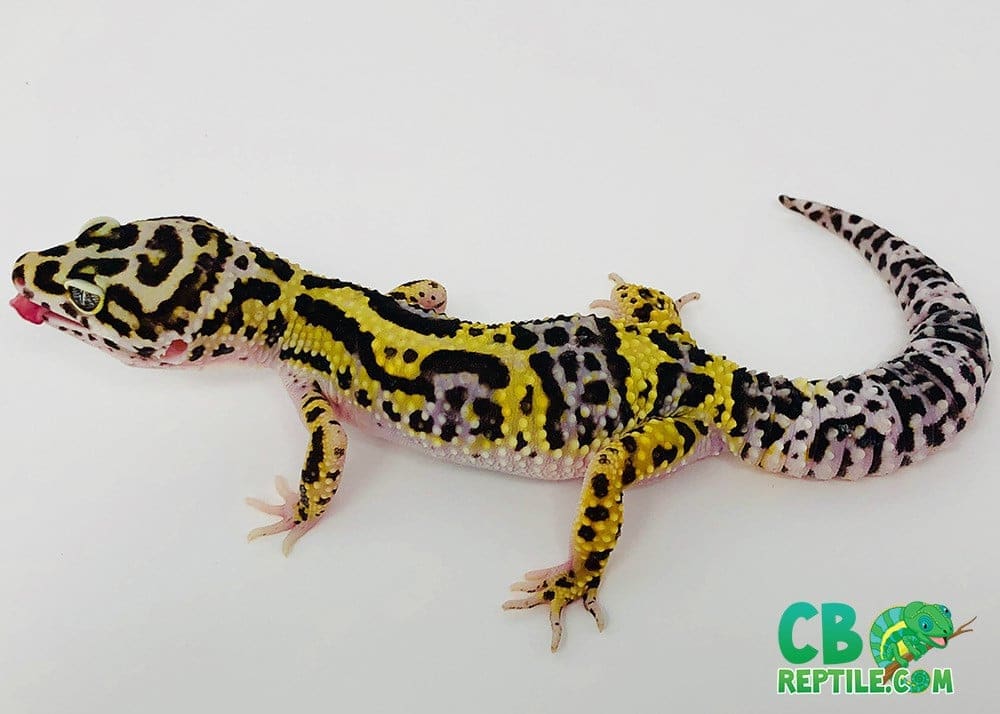
(photo credit cbreptile)
Jungle are much like an Aberrant except that the broken pattern is present on the tail and the body.
Marble Eye
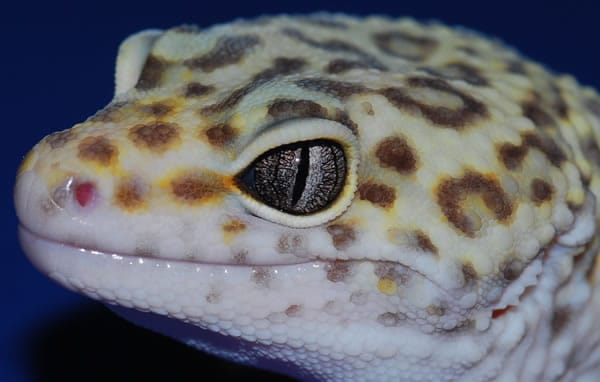
(photo credit reptileadvisor)
Very rare, their eyes resemble a marble giving them a sort of three-dimensional appearance.
Lavender

(photo credit amazingwallpapers)
Generally, a term given to any Leopard Gecko with lavender or violet variations on its body. Known to be quite tricky to produce, as they age, sometimes the marking that gives them their name can disappear.
Tangerine
(photo credit geckodaddy)
Tangerine can be applied to any gecko that displays a shade of orange, so it can be quite a general term.
Carrot Head

(photo credit Pinterest)
These morphs are known for their bright orange head, hence the name. The more orange the head, the more expensive these can be. Carrot Tails have orange on their tails rather than their heads, but the same applies to them.
Raptor
(photo credit VMSherp)
Raptor stands for Red-Eye Albino Patternless Tremper ORange. These morphs have red eyes and orange bodies. This morph is the product of combining Eclipse, Patternless Stripe, and Tremper Albino morphs. Reverse Stripe, Carrot Head, and APTOR morphs were all created during attempts to produce the RAPTOR morph.
APTOR
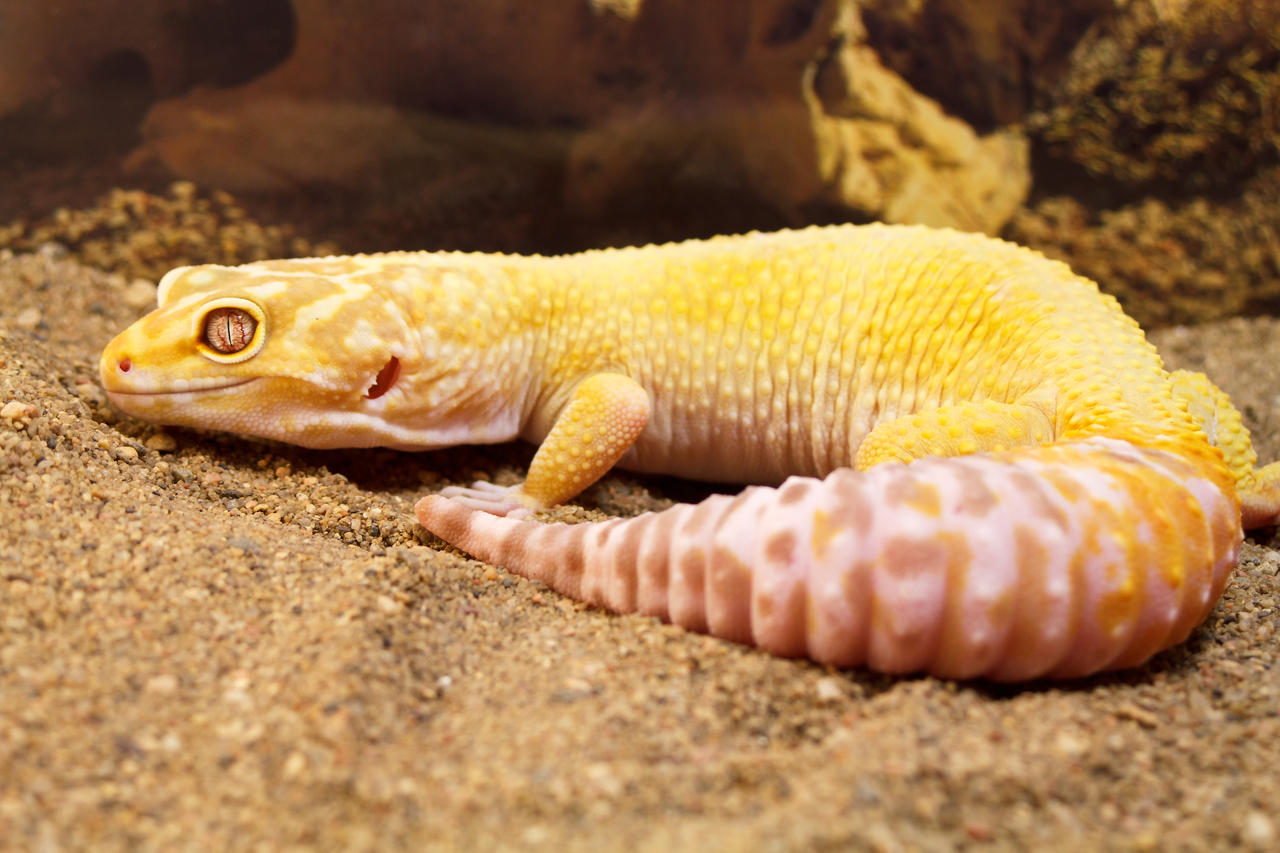
(photo credit Bizrate)
Albino Patternless Tremper Orange, same as the RAPTOR but without the red eyes.
Dreamsicle

(photo credit Pinterest)
This morph stems from combining the Enigma, RAPTOR, and Mack Snow morphs. They are usually an orange and white color hence the name.
Buying a Healthy Leopard Gecko
When it comes to buying a health gecko, there are several things to watch out for, take a look at out, check out our guides help with various aspects.
What To Look For In A Healthy Reptile

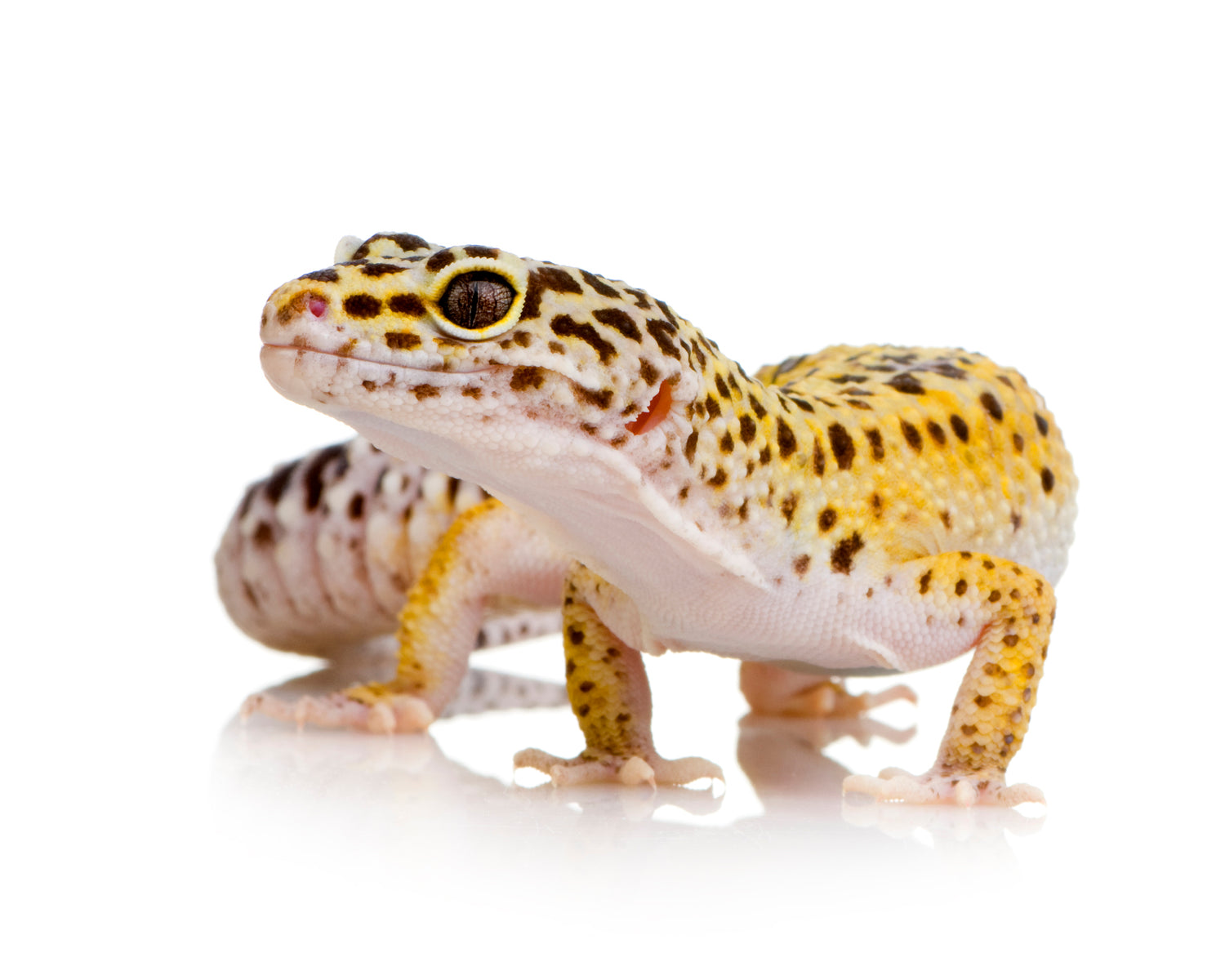
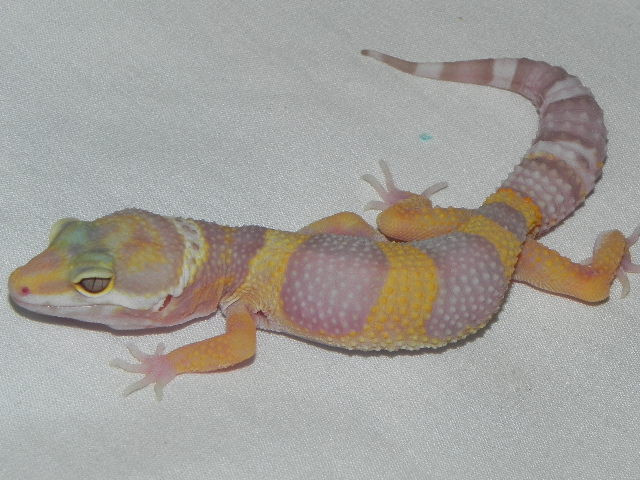

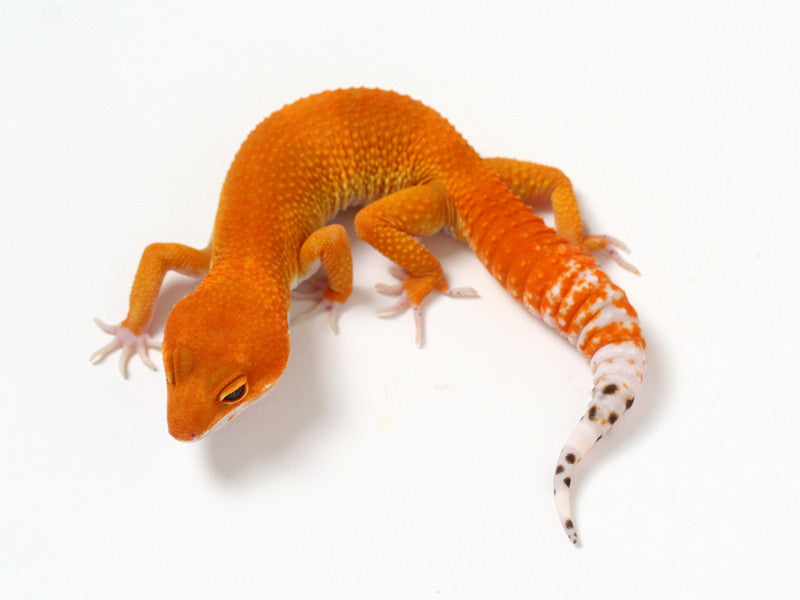

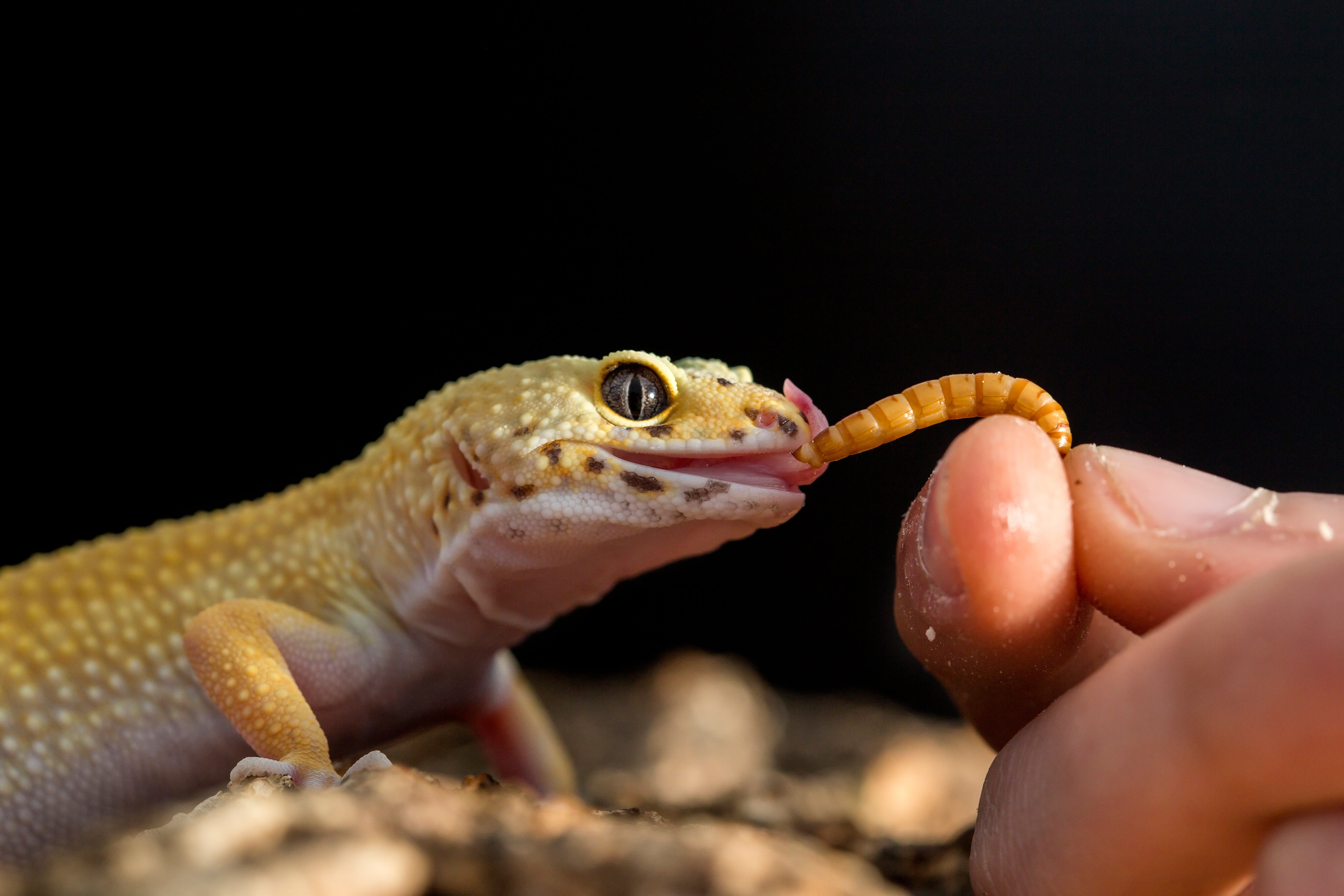
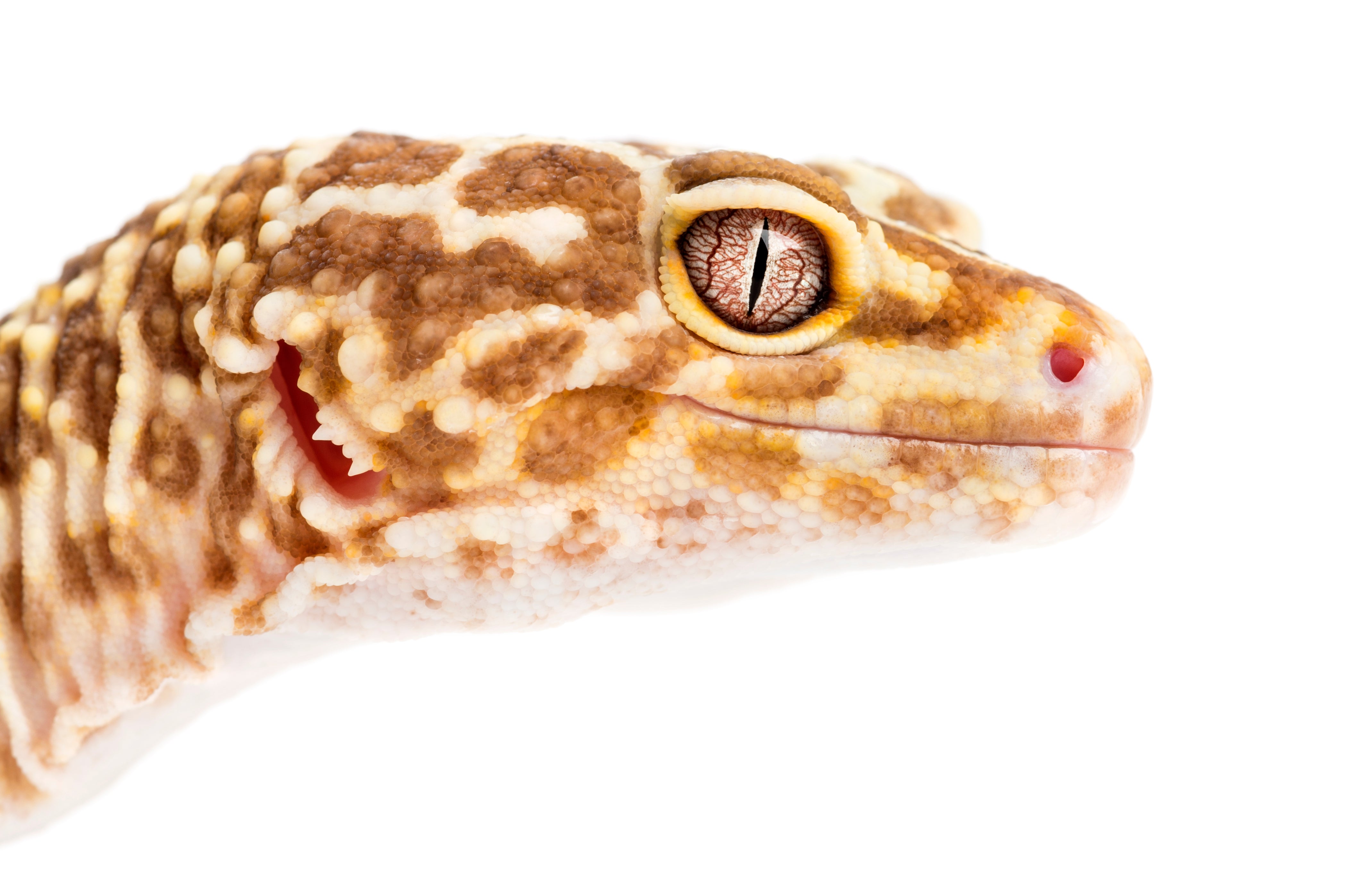
1 comment
Austin Benedict
I just wanted to say the creamsicle is the coolest gecko variant I have ever seen. It’s beautiful and the specimen you photographed looks very happy and healthy. :)
Leave a comment
All comments are moderated before being published.
This site is protected by hCaptcha and the hCaptcha Privacy Policy and Terms of Service apply.